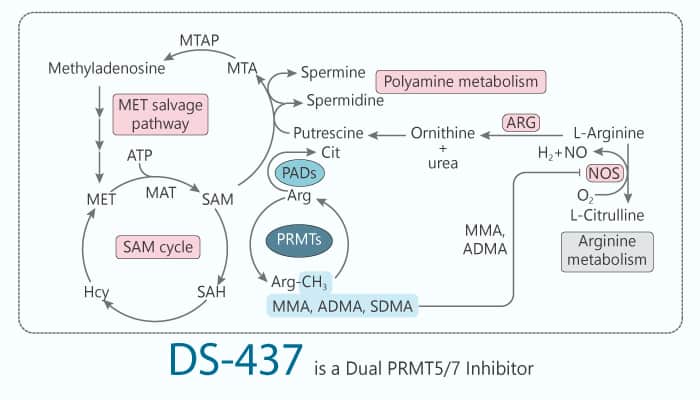Protein arginine methyltransferases are a class of enzymes. They transfer a methyl group from the cofactor S-adenosylmethionine (SAM) onto the arginine omega nitrogens of substrate proteins, including histones. There are three subclasses based on their product specificity: type I, II, and III PRMTs asymmetrically dimethylate, symmetrically dimethylate, and monomethylate their substrates, respectively. PRMT5 is currently the only known type II PRMT, and PRMT7 the only monomethylase. Meanwhile, PRMT5 methylates a number of substrates, both nuclear and cytoplasmic: methylation of arginine 3 of histone 4 (H4R3) by PRMT5 generates a binding site for DNMT3A. Furthermore, PRMT7 plays a role in the methylation of H3R2 as well as Sm proteins. Therefore, potent, selective, and cell-active chemical probes targeting PRMT5 and PRMT7 would be useful tools. They can investigate molecular pathways, phenotypic responses, and toxicity associated with the chemical inhibition of these methyltransferases. In this study, DS-437 is a dual PRMT5/7 inhibitor.

DS-437 is selective for PRMT5 and PRMT7 over 29 other human protein-, DNA-, and RNA-methyltransferases. It inhibits the PRMT5-MEP50 complex with an IC50 of 5.9 μM, and significantly inhibited PRMT7, with an IC50 of 6 μM. In addition, DS-437 shows an exquisite dual-specificity against PRMT5 and PRMT7 and residual activity against DNMT3A and DNMT3B. Moreover, DS-437 has some beneficial effects on inhibiting tumor growth. The combination of DS-437 and the anti-p185erbB2/neu antibody 4D5 has even more dramatic effects.
In summary, DS-437 is to our knowledge the first dual PRMT5-PRMT7 inhibitor. Thus, DS-437 behaves as a cofactor competitor. It also represents a valid scaffold to interrogate the potential of the PRMT5-PRMT7 axis as a target for therapy.
Reference:
Smil D, et al. ACS Med Chem Lett. 2015 Mar 2;6(4):408-12.